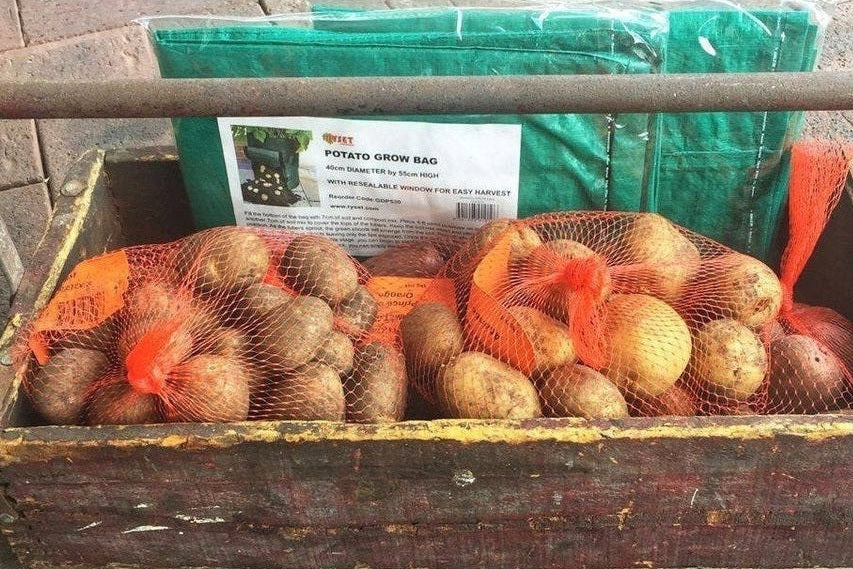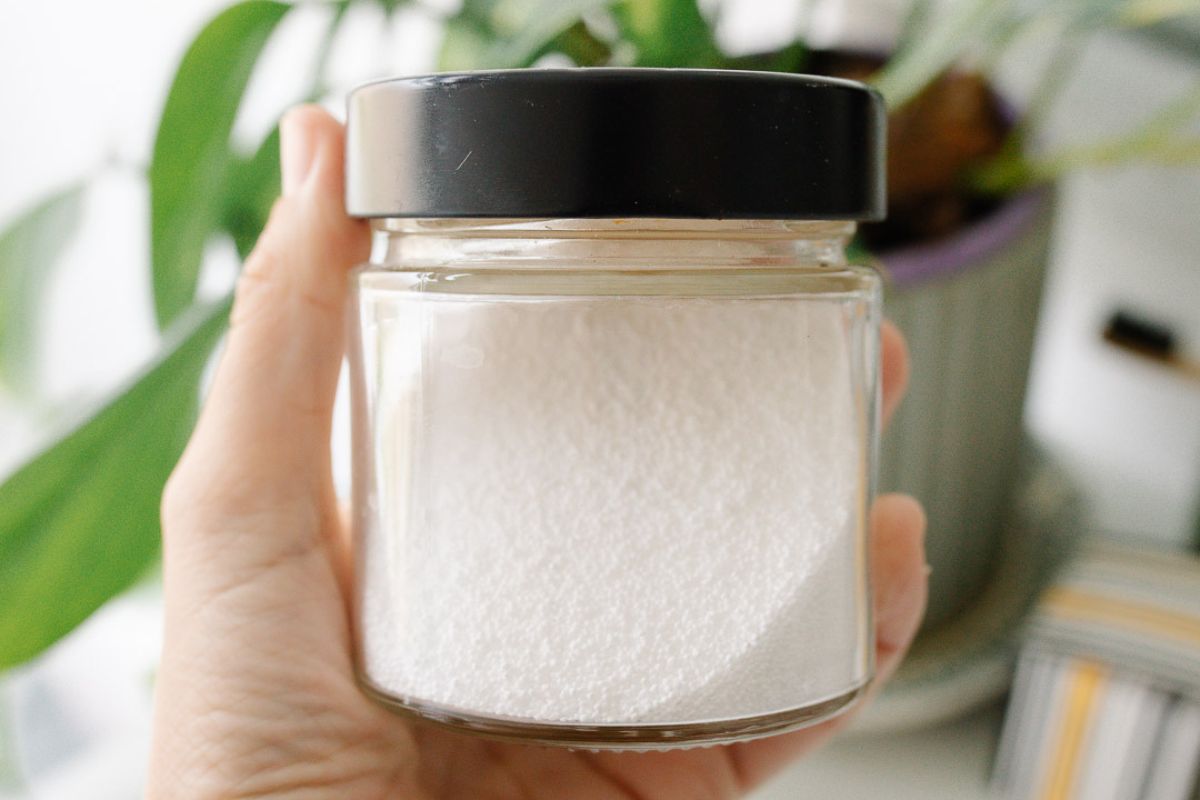While store-bought potatoes are readily available all year round, nothing beats the flavour of the home grown version. Potatoes can be grown in most climates if you choose a suitable variety. They can be grown in the ground, in pots, or in bags, making them a great choice no matter how much growing room you have.
This potato growing video has lots of useful tips and advice about growing potatoes in potato grow bags.
What Do You Need To Grow Potatoes?
- Somewhere to grow.Potatoes will grow well in garden beds, large pots, wire mesh towers and old coffee sacks. Perhaps the easiest way to grow them is in our Potato Grow Bags, which allow you to harvest regularly without disturbing the plant through the window at the base. Our large Root Pouches are another great choice.
- Seed potatoes. While potatoes can be grown from true seeds, the easiest way to grow them is by planting seed potatoes or tubers. Supermarket potatoes might produce potato plants but might also introduce disease to your garden that can take years to eradicate. Our Seed Potatoes are produced for us at Bathgate Farm near Albany and are certified disease free - our varieties are listed at the end of this article.
- Soil. Potatoes need deep, loose, free-draining soils that are slightly acidic with plenty of organic matter. They grow best in a mixture of compost, well-rotted manure and straw. Our Nutrarich Mature Compost and Straw Mulch are great options if you can’t make enough compost at home.
- Full sun.
- Water, but not too much – over-watering can lead to disease. Don’t use greywater to irrigate potatoes or other root vegetables.
- Nutrients. Potatoes are fairly hungry plants. Manure and compost are essential, but they also benefit from a little seaweed solution at planting time and again when they flower.



Before You Plant...
Potatoes grow best and produce the biggest harvests in cool weather, so autumn is a good time to plant them here in Perth. They don’t cope well with heat or frost.
Seed potatoes about the size of a chicken’s egg are ideal for planting. Larger seed potatoes can be cut into pieces, with each containing a few healthy-looking eyes. Cut potatoes should be left for a few days before planting to give the cut surfaces time to dry and callus.
Some gardeners like to pre-sprout their seed potatoes before planting, giving them a head start for a quicker and larger harvest. This process is called “chitting”. To do this, simply leave your seed potatoes in a cool, light place until they produce shoots about 5mm long – this may take a few weeks.

How To Grow Potatoes
The Traditional Way To Grow Potatoes
After preparing the soil by adding lots of organic matter, dig trenches or planting holes about 20cm deep in your garden bed. Lay out your seed potatoes, leaving about 25cm between each, and cover them with about 15cm of the same mix. When small green shoots begin to peek through, add another 15cm of the compost, manure and straw mixture. Continue to top up the manure and compost mixture throughout the growing season, creating hillocks over the garden beds. This will give the plants plenty of soil depth in which the tubers can form. Once the soil depth (from original seed potato to top of hillock) reaches about 60cm, leave your plants to keep growing.

Growing Potatoes In Containers or Potato Grow Bags
If growing in large pots, potato towers, or Potato Grow Bags, put down a 15-20cm layer of mixed compost, aged manure and straw in the base of your pot and water this in. Again, lay out your seed potatoes leaving about 25cm between them, and cover with about 15cm of the compost mixture. Continue to add this mixture as the potato shoots emerge through the surface. Once the container is full, leave the plants to continue growing.
See this article on The Fail-Safe Way To Grow Potatoes (Growing Potatoes In Bags)to see a video of Jo explaining this method of growing potatoes.


The Lazy Way To Grow Potatoes
When growing potatoes in containers, some gardeners choose to fill the container to the brim at the time of planting. This may produce a slightly smaller harvest but takes far less effort and time and your potatoes will still taste great. Have a look at this article for a comparison of traditional and lazy growing methods.
How To Harvest Potatoes
New or “baby” potatoes can be harvested just as the lower leaves begin to yellow. Mature potatoes can be harvested after flowering when the foliage dies back.
Gather just enough potatoes for one meal by carefully ferreting through the soil by hand. If you’ve grown your plants in our Potato Grow Bags you can easily collect just a few potatoes by tipping the bag a little and carefully reaching through the window. The remaining tubers can be left to grow undisturbed.
Collect all your container-grown potatoes at once by cutting off the foliage, emptying the container into a wheel barrow and sorting through the soil by hand. Potatoes grown in-ground are easily harvested using our fabulous Potato Harvesting Scoop – don’t use a gardening fork as the tines can easily cause damage.
After your mature potatoes have been lifted, spread them out in the shade to dry for a few hours before storing them.

How To Store Potatoes
New potatoes don’t store well and are best eaten within a few days of harvest.
Mature potatoes will store for 2 or 3 months provided that they are fully mature and their skins are undamaged. Check them carefully for soft spots, discolouration and other imperfections, then store your dirt-coated potatoes in a cool, dark place - exposure to sunlight causes potatoes to turn green and poisonous.
When preparing your potatoes for eating, use a Vegetable Brush to softly brush or wash the dirt off the potatoes without damaging them.

Crop Rotation
Growing different plant families in succession helps reduce nutrient depletion in a garden bed and reduces the chance of pests and diseases running rampant. It’s best not to plant potatoes where other members of the Solanum family (chillies, capsicums, tomatoes, eggplants) have grown in the last few years. If you can, plant your potatoes where legumes like beans and peas have grown previously, as these plants add the nitrogen that potatoes love to the soil.
After harvesting your potatoes, use this spot in the garden to grow leafy greens.
Companion Planting
Potatoes grow well with basil, beans, beetroot, Brussels sprouts, cabbage, cauliflower, corn, horseradish, marigolds, marjoram, nasturtiums and peas.
Don’t plant them near apples, celery, cucumbers, pumpkins, squash, sunflowers, tomatoes or raspberries.
Bathgate Farm Seed Potato Varieties
|
Atlantic |
Australia’s major frying variety. |
Round with pale skin, white flesh & deep eyes. |
A mid-season variety. |
|
|
Delaware |
Good for boiling & roasting, excellent for gnocchi. |
A medium to large potato with creamy skin & white flesh. |
Matures relatively early. |
Plant is extremely vigorous. |
|
Desiree |
An excellent all-purpose variety. Holds its shape well. Good for boiling, baking, mashing & in salads. Not recommended for frying. |
Pink skin & firm, pale yellow flesh. |
A late-season variety. |
|
|
Mozart |
Good for mashing, roasting & frying. |
Smooth red skin with yellow flesh. |
A late-season variety. |
Good resistance to slugs. |
|
Nicola |
A waxy potato with a buttery flavour. Excellent salad or boiling potato, also good for mashing, baking, gnocchi & gratins. Not recommended for frying. |
Long to oval shape with yellow skin & flesh. |
Can be grown all year round. |
|
|
Norland |
A waxy potato, excellent for boiling & salads. Good for frying. Not recommended for baking. |
Red skinned with white flesh. Medium oblong shape with shallow eyes. |
Early to mid-season variety. |
Good disease resistance, stores well. |
| Prince of Orange |
A long oval-shaped potato with smooth, red skin and dark yellow flesh. |
Creamy, buttery taste. |
Very versatile potato suitable for boiling, steaming, roasting and frying. |
|
|
Ranger Russet |
A floury potato, best for baking & frying. |
Long, slightly flattened potato with russet-brown skin & white flesh. |
A late-maturing potato. |
|
|
Royal Blue |
An all-purpose variety. Good for mashing, roasting, frying & most cooking methods. |
Oval with purple skin & yellow flesh. |
An early season variety. |
Skin finish can suffer if left in the ground too long. |
|
Ruby Red |
A versatile general purpose potato with great flavour. Excellent for dry baking, roasting, mashing, boiling, microwaving & frying. |
Oblong potato with vibrant red skin & yellow flesh. |
An early season variety. |
High yielding variety, stores well. |
| Imperial Blue | An all purpose variety, great for roasting. | Blue skin and yellow flesh. | Early maturing variety. | |
| Neptune | A medium sized potato useful for frying and roasting. | Oval shape, white flesh and white skin with small eyes. | Early maturing variety. |
References
Vegetable growing: a guide for home gardeners in Western Australia (Department of Agriculture, Western Australia)
Sustainable Gardening Australia https://www.sgaonline.org.au/potatoes/
Growing Potatoes by Ignoring Them (Epic Gardening) https://www.youtube.com/watch?v=_1SWKNOXEJ0
“Free Plants for Everyone – The Good Guide to Plant Propagation”, David the Good
https://www.gardenmyths.com/potato-towers-high-yields/
“The Resilient Gardener”, Carol Deppe
“How to Grow More Vegetables”, John Jeavons







Penny
June 20, 2023
Another great blog post – I love reading your articles, so informative and helpful – thanks!